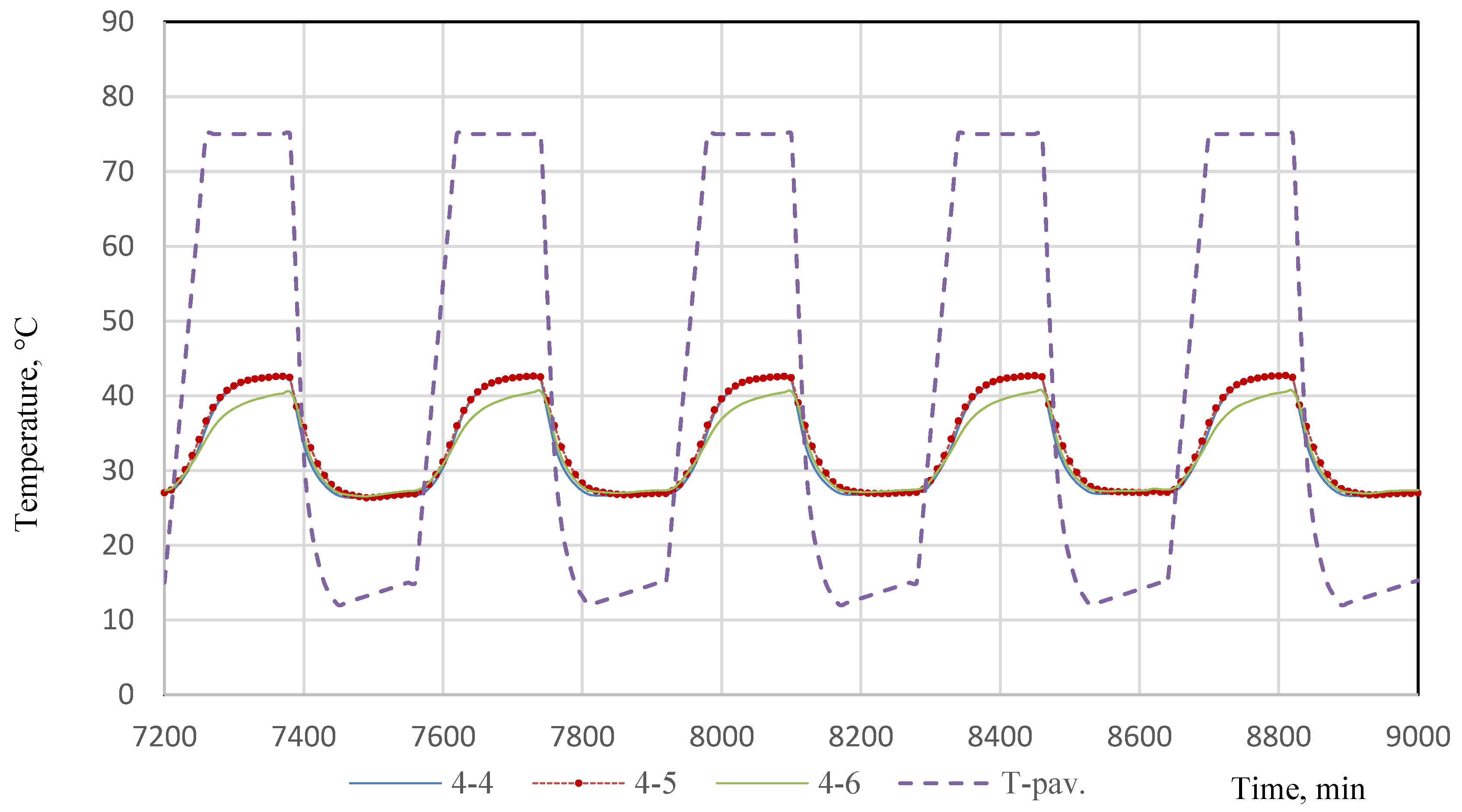Verification of External Thermal Insulation Systems with Composite Thermal Insulation and Different Renders in Effect of Hydrothermal Stress †
Abstract
:1. Introduction
2. Materials and Testing Methods
3. Results and Discussion
- -
- blistering or peeling of any finishing;
- -
- failure or cracking associated with joints between insulation product boards;
- -
- detachment of render;
- -
- cracking allowing water penetration to the insulation layer.
4. Conclusions
Author Contributions
Conflicts of Interest
References
- Daniotti, B.; Paolini, R. Evolution of degradation and decay in performance of ETICS. In Proceedings of the 11th International Conference on Durability of Building Materials and Components, Istanbul, Turkey, 11 May 2008; p. 42. [Google Scholar]
- Gaciek, P.; Gaczek, M.; Garecki, M. Sposoby Mocowania Ociepleń do Powierzchni Ścian Według Technologii ETICS; Warsaw, Poland, 2018; Izolacje 10/2018. [Google Scholar]
- Liismaa, E.; Sepria, R.; Raadob, L.-M.; Lillc, I.; Wittd, E.D.Q.; Sulakatkoc, V.; Põldarua, M. Defect analysis of renovated facade walls with etics solutions in cold climate conditions. In Proceedings of the Central Europe Towards Sustainable Building, Prague, Czech Republic, 22–24 June 2016. [Google Scholar]
- Pečur, I.B.; Bjegović, D.; Boström, L.; Milovanović, B. ETICS Fire Performance Test. In Proceedings of the Fifth International Workshop on Performance, Protection & Strengthening of Structures Under Extreme Loading, East Lansing, MI, USA, 28–30 June 2015; Available online: https://www.researchgate.net/publication/280385277_ETICS_Fire_Performance_Test (accessed on 15 December 2018).
- Sulakatko, V.; Liisma, E.; Soekov, E. Increasing Construction Quality of External Thermal Insulation Composite System (ETICS) by revealing on-site degradation factors. Procedia Environ. Sci. 2017, 38, 765–772. [Google Scholar] [CrossRef]
- Sulakatko, V.; Vogdt, F. Construction process technical impact factors on degradation of the external thermal insulation composite system. Sustainability 2018, 10, 3900. Available online: https://www.openaire.eu/search/publication?articleId=doajarticles::71bd2596e525ffed015fe1825443267f (accessed on 10 February 2020). [CrossRef]
- Barreira, E.; de Freitas, V.P. Experimental study of the hygrothermal behaviour of external thermal insulation composite systems (ETICS). Build. Environ. 2013, 63, 31–39. [Google Scholar] [CrossRef]
- Liisma, E.; Lõhmus, G.; Raado, L. The effect of temperature and humidity on the permanence of external thermal insulation composite systems. Procedia Eng. 2015, 108, 340–348. [Google Scholar] [CrossRef]
- Šadauskienė, J.; Buska, A.; Ramanauskas, J.; Algimantas, V. Analysis of fire spread prevention measures in ETICS and their influence on durability. J. Sustain. Arch. Civ. Eng. 2016, 17, 33–44. Available online: https://www.ceeol.com/search/article-detail?id=570694 (accessed on 15 January 2020).
- Steinbauer, V.; Kaufmann, J.; Zurbriggen, R.; Bühler, T.; Herwegh, M. Tracing hail stone impact on external thermal insulation composite systems (ETICS)—An evaluation of standard admission impact tests by means of high-speed-camera recordings. Int. J. Impact Eng. 2017, 109, 354–365. Available online: https://www.sciencedirect.com/science/article/pii/S0734743X16309186 (accessed on 15 January 2020). [CrossRef]
- Barreira, E.; de Freitas, V.P. External thermal insulation composite systems: Critical parameters for surface hygrothermal behaviour. Adv. Mater. Sci. Eng. 2014, 2014, 1–16. [Google Scholar] [CrossRef]
- Barreira, E.; de Freitas, V.P. Importance of thermography in the study of etics finishing coatings degradation due to algae and mildew growth. In Proceedings of the 10DBMC International Conference on Durability of Building Materials and Components, Lyon, France, 17–20 April 2005. [Google Scholar]
- Mandilaras, I.; Atsonios, I.; Zannis, G.; Founti, M. Thermal performance of a building envelope incorporating ETICS with vacuum insulation panels and EPS. Energy Build. 2014, 85, 654–665. [Google Scholar] [CrossRef]
- Kvande, T.; Bakken, N.; Bergheim, E.; Thue, J. Durability of ETICS with rendering in Norway—Experimental and field investigations. Buildings 2018, 8, 93. Available online: https://search.proquest.com/docview/2125297481 (accessed on 21 January 2020). [CrossRef]
- Sulakatko, V.; Lilla, I.; Witta, E. Methodological framework to assess the significance of External Thermal Insulation Composite System (ETICS) on-site activities. Energy Procedia 2016, 96, 446–454. [Google Scholar] [CrossRef]
- Steidl, T.; Krause, P. Moisture transport in cellular concrete walls with the connector for thermal insulation. Periodica Polytech. Civ. Eng. 2018, 62, 986–991. [Google Scholar] [CrossRef]
- Uygunoğlu, T.; Özgüven, S.; Çalış, M. Effect of plaster thickness on performance of external thermal insulation cladding systems (ETICS) in buildings. Constr. Build. Mater. 2016, 122, 496–504. Available online: https://www.sciencedirect.com/science/article/pii/S0950061816310662 (accessed on 20 January 2020). [CrossRef]
- Norvaišienė, R.; Griciutė, G.; Bliūdžius, R.; Ramanauskas, J. The changes of moisture absorption properties during the service life of external thermal insulation composite system. Mater. Sci. 2013, 19, 103–107. Available online: https://www.openaire.eu/search/publication?articleId=doajarticles::455354cd761fca8fcc5905c5acebc211 (accessed on 25 January 2020). [CrossRef]
- ETAG 004 Guideline for European Technical Approval of External Thermal Insulation Composite Systems with Rendering; European Organization for Technical Approvals: Brussels, Belgium, March 2013.



| Adhesion Strength after Hydrothermal Cycles | |||
|---|---|---|---|
| System | Place | Average Value, MPa | Rupture Description |
| ETICS No. 1 | From EPS | 0.11 | cohesive |
| At the joint EPS/MW | 0.05 | cohesive | |
| ETICS No. 2 | From EPS | 0.11 | cohesive |
| At the joint EPS/MW | 0.05 | cohesive | |
| ETICS No. 3 | From EPS | 0.10 | cohesive |
| At the joint EPS/MW | 0.05 | cohesive | |
| ETICS No. 4 | From EPS | 0.10 | cohesive |
| At the joint EPS/MW | 0.05 | cohesive | |
Publisher’s Note: MDPI stays neutral with regard to jurisdictional claims in published maps and institutional affiliations. |
© 2020 by the authors. Licensee MDPI, Basel, Switzerland. This article is an open access article distributed under the terms and conditions of the Creative Commons Attribution (CC BY) license (https://creativecommons.org/licenses/by/4.0/).
Share and Cite
Norvaisiene, R.; Krause, P.; Buhagiar, V.; Burlingis, A.; Miskinis, K. Verification of External Thermal Insulation Systems with Composite Thermal Insulation and Different Renders in Effect of Hydrothermal Stress. Proceedings 2020, 51, 16. https://doi.org/10.3390/proceedings2020051016
Norvaisiene R, Krause P, Buhagiar V, Burlingis A, Miskinis K. Verification of External Thermal Insulation Systems with Composite Thermal Insulation and Different Renders in Effect of Hydrothermal Stress. Proceedings. 2020; 51(1):16. https://doi.org/10.3390/proceedings2020051016
Chicago/Turabian StyleNorvaisiene, Rosita, Paweł Krause, Vincent Buhagiar, Arūnas Burlingis, and Kestutis Miskinis. 2020. "Verification of External Thermal Insulation Systems with Composite Thermal Insulation and Different Renders in Effect of Hydrothermal Stress" Proceedings 51, no. 1: 16. https://doi.org/10.3390/proceedings2020051016






